Active 1981 – present Size ~2,700 | ||
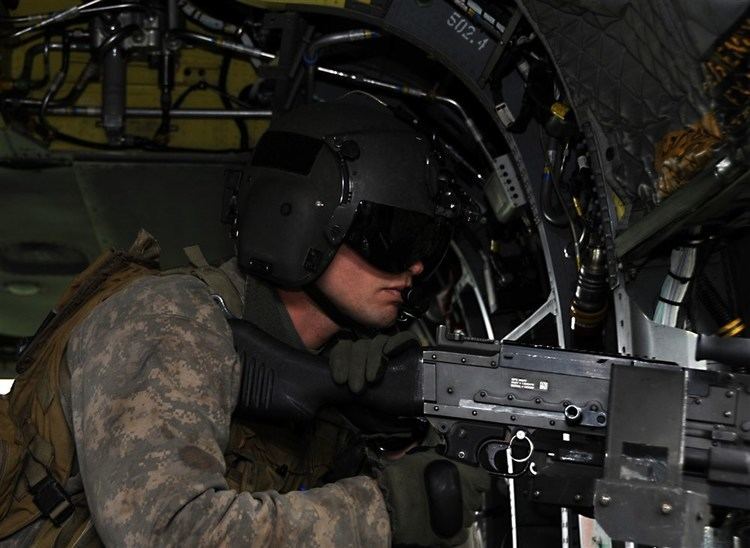 | ||
Country United States of America Type Special operations aviation Part of United States Special Operations Command United States Army Special Operations Command U.S. Army Special Operations Aviation Command | ||
Fort report co e 160th special operations aviation regiment airborne
The United States Army 160th Special Operations Aviation Regiment (Airborne), abbreviated as the 160th SOAR (A) and also known as Night Stalkers, or within JSOC as Task Force Brown, is a special operations force of the United States Army that provides helicopter aviation support for general purpose forces and special operations forces. Its missions have included attack, assault, and reconnaissance, and are usually conducted at night, at high speeds, low altitudes, and on short notice. The 160th SOAR is headquartered at Fort Campbell, Kentucky.
Contents
- Fort report co e 160th special operations aviation regiment airborne
- Overview
- Equipment
- 1980s and 1990s
- War on Terror
- Organization
- In popular culture
- References
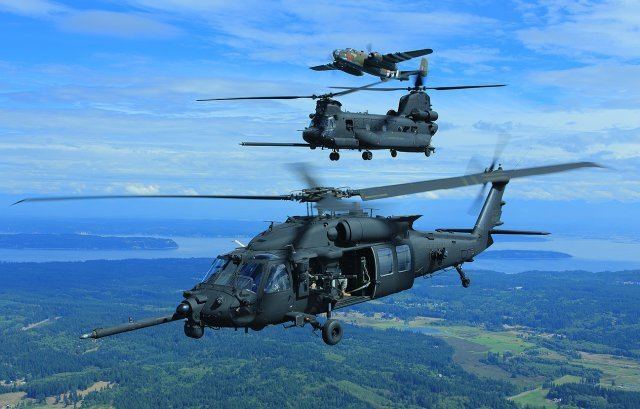
Commander: COL John R. Evans
Command Sergeant Major: CSM Gregory Chambers
Regimental Warrant Officer: CW5 Ivan S. Murdock
Overview
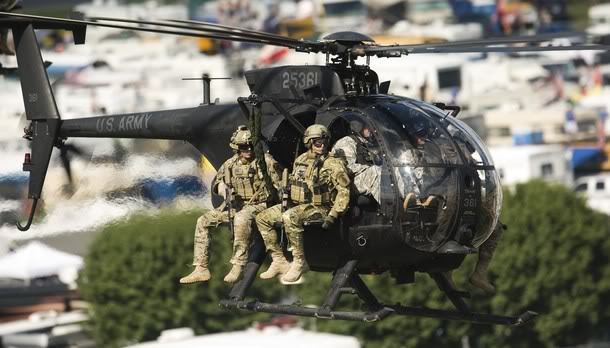
The 160th SOAR (A) consists of the Army's best-qualified aviators, Crew Chiefs and support soldiers. Officers volunteer while enlisted soldiers volunteer or are assigned by the U.S. Army Human Resources Command. All soldiers receive intensive training upon joining the 160th and are required to pass the Green Platoon course. The basic Night Stalker course for enlisted soldiers lasts five weeks; the officer course lasts 20 to 28 weeks.

A new Night Stalker arrives to his unit Basic Mission Qualified (BMQ); after a series of test qualifications, experience and leadership, the Night Stalker is designated Fully Mission Qualified (FMQ). After three to five years as an FMQ, the Night Stalker will have the chance to assess for flight lead qualification. The 160th previously recruited only men for combat positions, but as of June 2013 has opened those positions to women as well.
Equipment
The 160th SOAR fly MH-47G Chinooks, A/MH-6M Little Birds and MH-60M Black Hawks.
1980s and 1990s
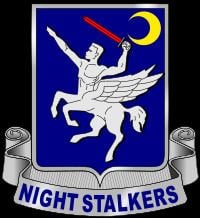
After the 1980 Operation Eagle Claw attempt to rescue American hostages held in Tehran, Iran, failed, President Jimmy Carter ordered former Chief of Naval Operations Adm. James L. Holloway III to figure out how the U.S. military could best mount another attempt. At the time there were no U.S. helicopter units trained in this kind of stealthy, short-notice Special Operations mission.

The Army looked to the 101st Aviation Group, the air arm of the 101st Airborne Division (Air Assault), which had the most diverse operating experience of the service's helicopter units, and selected elements of the 158th Aviation Battalion, 101st Aviation Battalion, 229th Aviation Battalion, and the 159th Aviation Battalion. The chosen pilots immediately entered intensive training in night flying.
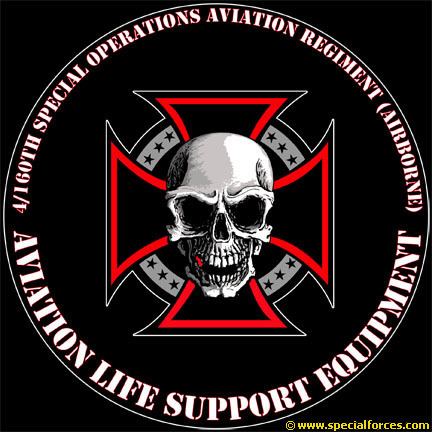
This provisional unit was at first dubbed Task Force 158 since the majority of the pilots were Blackhawk aviators detached from the 158th. Their distinctive 101st "Screaming Eagle" patches remained on their uniforms. The Blackhawks and Chinooks continued to operate around Campbell Army Airfield at the north of post, and Saber Army Heliport at the south. The OH-6 Cayuses, an aircraft that had vanished from the division's regular inventory after Vietnam, were hidden on the base by an ammunition holding area still known as the "SHOC Pad", for "Special Helicopter Operations Company".
As the first batch of pilots completed training in the fall of 1980, a second attempt to rescue the hostages was planned for early 1981. Dubbed Operation Honey Badger, it was called off when the hostages were released on the morning of President Ronald Reagan's inauguration.
The capability gained was judged too important to future contingencies to lose. The new unit was quickly recognized as the Army's premier night fighting aviation force, and its only Special Operations Aviation force. The pilots and modified aircraft would not be returned to the 101st. Original members of the Night Stalkers refer to it as "the day the Eagles came off". The 101st's patches came off, the personnel and equipment would be reassigned, and a new tradition was born. The unit was officially established on 16 October 1981, when it was designated as the 160th Aviation Battalion.
The 160th first saw combat during 1983's Operation Urgent Fury, the U.S. invasion of Grenada.
In 1986, it was re-designated as the 160th Aviation Group (Airborne); and in May 1990, the 160th Special Operations Aviation Regiment (Airborne). As demand for highly trained Special Operations Aviation assets bloomed, the regiment activated three battalions, a separate detachment, and incorporated one Army National Guard unit, the 1st Battalion, 245th Aviation (OK ARNG).
In 1987 and 1988, its pilots took part in Operation Earnest Will, the protection of re-flagged Kuwaiti tankers in the Persian Gulf during the Iran–Iraq War. They flew from US Navy warships and leased oil barges in a secret sub-part called Operation Prime Chance, and became the first helicopter pilots to use night vision goggles and forward looking infrared devices in night combat.
In June 1988, the unit executed Operation Mount Hope III. Two MH-47 crews flew 490 miles (790 km) deep into Chad to retrieve a crashed Mi-24 Hind medium-attack helicopter.
The Night Stalkers spearheaded Operation Just Cause, the 1989 invasion of Panama, and they were also used in Operation Desert Storm in 1991.
In October 1993 in Somalia, Night Stalkers became involved in the Battle of Mogadishu, which later became the subject of the book Black Hawk Down, and its film adaptation. Two Night Stalker Black Hawks, Super 6-1 (piloted by Cliff Wolcott), and Super 6-4 (piloted by Mike Durant), were shot down in the battle. Five of the eighteen men killed (not counting a nineteenth post-operation casualty) in the Battle of Mogadishu were members of the SOAR(A) Night Stalkers team, who were lost along with the two Black Hawks.
War on Terror
During the 2001 invasion of Afghanistan, the Nightstalkers from 2nd Battalion 160th SOAR were tasked with supporting Task Force Dagger, Nightalkers were also tasked with supporting Task Force Sword, their component in TF Sword was known as Task Force Brown, both TFs were established in early October 2001. In the evening of 18 October into 19 October 2001, two SOAR MH-47E helicopters, escorted by MH-60L DAPs (Direct Action Penetrators), airlifted Operational Detachment Alpha (ODA) 555 and 595, both 12-man Green Beret teams from the 5th SFG, plus four Air Force Combat Controllers, from the Karshi-Khanabad Air Base in Uzbekistan more than 300 kilometers (190 mi) across the 16,000 feet (4,900 m) Hindu Kush mountains into Afghanistan. The pilots of the Chinooks, flying in zero-visibility conditions, were refueled in-flight three times during the 11-hour mission, establishing a new world record for combat rotorcraft missions at the time. They linked up with the CIA and Northern Alliance. Within a few weeks the Northern Alliance, with assistance from the U.S. ground and air forces, captured several key cities from the Taliban. In November 2001, the Nightstalker AH-6J Little birds took part Objective Wolverine and Raptor missions and Operation Relentless Strike. In December 2001, Night Stalker crews were essential in resupplying over 150 Delta Force, British SBS and CIA SAD operatives during their hunt for Osama bin Laden in the Tora Bora mountain complex.
In January 2002, in Afghanistan, Task Force Sword was renamed Task Force 11 and was manned by a DEVGRU, a company of Rangers and were supported by a company of helicopters from the 160th SOAR. On 21 February 2002, whilst scouting Islamist terrorists on Basilan Island and seeking to rescue a nurse and an American missionary couple, a MH-47 crashed at sea in the Bohol Strait, southern Philippines killing 10 servicemen (8 from E company, 160th SOAR and 2 from the 353rd Special Operations Group). In March 2002, Nightstalkers from B company 2nd Battalion 160th SOAR supported coalition troops during Operation Anaconda, particularly at the Battle of Takur Ghar on March 4, where one of their MH-47E, callsign: Razor 03, was damaged by RPG fire and crash-landed carrying Mako 30. A second MH-47E, callsign: Razor 01, that was responding to the shootdown and carrying a QRF, was damaged by small arms and RPG fire and crash landed, by the end of the battle, one Nightstalker was killed. On 21 June 2002 in the Philippines, Nightstalker MH-47Es were involved in the operation that killed Abu Sabaya, a senior leader in the ASG. A US Predator UAV marked the HVT with an infrared laser as he tried to escape in a smugglers boat, the MH-47Es used search lights mounted on their helicopters to pinpoint the target's boat while operators from the Philippine Naval Special Operations Group opened fire on the boat killing the terrorist leader and capturing 4 other terrorists with him.
During the 2003 invasion of Iraq, 3rd Battalion 160th SOAR deployed as the Joint Special Operations Air Detachment-West under CJSOTF-West (Combined Joint Special Operations Task Force-West/Task Force Dagger), they were equipped with 8 MH-47E Chinooks, 4 MH-60L DAPs, and 2 MH-60M Black Hawks. At 21:00 on 19 March 2003, the first strike of Operation Iraqi Freedom was carried out by members of the 160th SOAR: a flight of MH-60L DAPs and four 'Black Swarm' flights - each consisting of a pair of AH-6M Little Birds and a FLIR equipped MH-6M to identify targets for the AH-6s (each Black swarm flight was assigned a pair of A-10As) engaged Iraqi visual observation posts along the southern and western borders of Iraq. In the space of seven hours, more than 70 sites were destroyed, effectively depriving the Iraqi military of any early warning of the coming invasion. As the sites were eliminated the first heliborne SOF teams launched from H-5 airbase in Jordan, including vehicle-mounted patrols from the British and Australian special forces, who were transported by the MH-47Es of the 160th SOAR. Nightstalkers from 1st Battalion 160th SOAR were tasked with supporting Task Force 20 with its MH-60M Blackhawks, MH-60L DAPs, MH-6M transport and AH-6M Little Birds, they based at Ar'Ar. On March 26, the 160th SOAR took part in the Objective Beaver mission, a raid by DEVGRU on a complex know as al Qadisiyah Research Centre that was suspected to have stocks of Chemical and Biological weapons. On April 1, 2003, the 160th SOAR took part in the rescue mission of PFC Jessica Lynch who was taken prisoner during the Battle of Nasiriyah. On April 2, a Delta Force squadron operating in Iraq was ambushed by half a dozen armed technicals from an anti-special forces Fedayeen, 2 MH-60K Blackhawks carrying a para jumper medical team and 2 MH-60L DAPs of the 160th SOAR responded and engaged the Iraqis, which allowed the Delta operators to move their 2 casualties to an emergency HLZ, however one Delta Force operator succumbed to his wounds.
On the evening of December 13, 2003, Saddam Hussein was captured by US forces in Operation Red Dawn, he was exfiltrated by a MH-6 Little Bird from the 160th SOAR and he was taken into custody at Baghdad International Airport. In 2004 they took part in the rescue of three Italian contractors and one Polish businessman held for ransom by Iraqi insurgents.
Afghanistan, 2005: Eight Night Stalkers were lost along with eight Navy SEALs on a rescue mission for Marcus Luttrell, after their MH-47 Chinook helicopter was hit by an RPG (rocket propelled grenade). They were sent out to look for Luttrell after Operation Red Wings, in which he was involved with three other SEALs, was compromised and Luttrell's teammates killed. The Night Stalkers lost on the search and rescue mission included:
In March 2006, allegedly under the codename: Operation Vigilant Harvest SEALS from DEVGRU and Rangers were flown by the 160th SOAR into in North Waziristan, Pakistan, to assault an al-Qaeda training camp, the assaulters killed as many as 30 terrorists including the camps commandant. On 14 May 2006, helicopters from the 160th SOAR were inserting operators from B squadron Delta Force in Yusufiyah, Iraq, so they could conduct a mission against al-Qaeda fighters in several, buildings/dwellings. As the Operators disembarked their helicopters they come under fire from a nearby house, the situation rapidly escalated into a battle quickly as more al-Qaeda fighters joined the firefight. The 160th's Black Hawks door gunners engaged the insurgents and a pair of AH-6M Little Birds carried out strafing runs, however one Little Bird from B company 1st Battalion 160th SOAR was shot down, an estimated 25 al-Qaeda fighters were killed in the mission. In July 2006, a pair of MH-47Es from 160th SOAR attempted to insert a combined strike element of DEVGRU, Rangers and Afghan commandos in Helmand Province, Afghanistan, so it could attack a target compound. With some troops on the ground, a large insurgent force ambushed them, both helicopters were struck by small arms fire, one MH-47E pilot put his aircraft directly in the line of fire protecting the other MH-47E whose assault team it was carrying was still disembarking. Inevitably the MH-47E was hit by an RPG which caused it to crash-land, the skill of the Nightstalker pilots saved the operators and the aircrew, no one was seriously wounded in the crash. The Ranger commander and an attached Australian Commando organised an all-round defence while the other MH-47E held back the advancing insurgents until its miniguns ran out of ammunition, an AC-130 Spectre joined the battle and kept the down crew and passengers safe until a British Immediate Response Team helicopter successfully recovered them, the AC-130 then destroyed the MH-47E wreck - denying it to the Taliban.
Night Stalker helicopters were present during the 2008 SOCOM counter-terror exercises in Denver. On 24 April 2008, Company D, 3rd Battalion, 160th SOAR was inactivated at a ceremony conducted at Hunter Army Airfield, GA, as part of an overall regimental transformation plan. The 160th SOAR also took part in the 2008 Abu Kamal raid.
On 19 August 2009, four Night Stalkers from D Company, 1st Battalion, 160th SOAR lost their lives in a MH-60 Black Hawk helicopter crash in Leadville, Colorado, during a mountain and environmental training. On 9 September 2009 in Afghanistan, Nightstalkers inserted the British SBS and SFSG into Kunduz Province to rescue Times journalist Stephen Farrell after he and his Afghan interpreter were captured by the Taliban. On 22 October 2009, a 3rd Battalion helicopter crashed into the USNS Arctic during a joint training exercise involving fast roping about 20 miles off Fort Story, Virginia. The crash killed a soldier, Sergeant First Class James R. Stright, 29, and injured eight others, three seriously.
In May 2011, the Night Stalkers provided insertion and cover for the raid on Osama bin Laden's compound.
On 28 May 2012, Operation Jubilee took place: Blackhawks from the 160th SOAR flew in a teams from the British 22nd SAS Regiment and DEVGRU into Badakhshan Province, Afghanistan so they could rescue a British aid worker, a Kenyan NGO worker and 2 Afghans who were taken hostage by Bandits in the province. The rescue was a success.
On 15 January 2014, a MH-60M Black Hawk of the 160th performed a hard landing at Hunter Army Airfield in Georgia. One soldier, CPT Clayton Carpenter of NY, was killed with another two injured. On 4 July 2014, during Operation Inherent Resolve, the Night Stalkers inserted Delta Force operators into Syria to rescue James Foley and other US hostages. One American was wounded, no hostages were found, but a substantial number of terrorists were killed. CENTCOM mistakenly posted a video on the internet of a flight of four MH-60Ms of the 160th SOAR conducting a mid-air refueling over Iraq in October 2014, the video has hastily taken down. On November 26 2014, MH-60s flown by Nightstalkers took part in the first raid in the 2014 hostage rescue operations in Yemen.
The Night Stalkers continue to be deployed to Afghanistan as part of NATOs Resolute Support Mission after Operation Enduring Freedom-Afghanistan ended in late 2014 and was replaced with Operation Freedom's Sentinel. Throughout that night of 5 December 2015, a group of Rangers engaged in a firefight with enemy troops near the Afghan-Pakistan border; after about 5 a.m. their commander called for an extraction after they learned of a larger enemy group approaching. A helicopter from the 160th SOAR arrived and began and received heavy fire from the enemy, an AH-64 Apache helicopter from the 1st Battalion 101st Aviation Regiment escorting the helicopter, put their Apache directly between the U.S. troops, the helicopter and the enemy forces to draw the fire. As a result, the extraction was a success.
Organization
Commander: COL John R. Evans
Command Sergeant Major: CSM Gregory Chambers
Regimental Warrant Officer: CW5 Ivan S. Murdock
In popular culture
The 160th featured prominently in the movie Black Hawk Down (film)
The 160th figures prominently in M. L. Buchman's Night Stalkers novel series and related short stories with minor roles in the Firehawks series.
